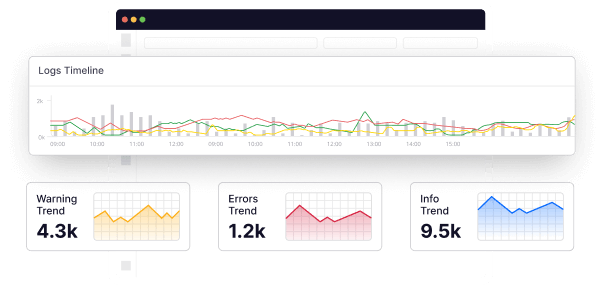DevOps – a portmanteau of Development and Operations – is a functional, smart combination of cultural philosophies, tools, and practices that improve an organization’s output and efficiency in delivering applications and services to the end users.
Seeing how this methodology of development benefits the throughput of a company, organizations across the world are increasingly adopting the DevOps approach in their IT cycles.
In fact, an Atlassian survey revealed that 99% of the respondents agreed that DevOps positively impacted their organization.
Having said that, merely implementing the DevOps approach in your organization isn’t enough. You need a way to track its performance and tweak it where necessary to fit better with how your organization works.
Through this blog, you will learn about the key DevOps metrics you should be tracking, the DevOps tools you need to measure them, and the best practices that allow you to implement DevOps seamlessly at your company.
Understanding DevOps metrics
DevOps metrics are definitive data points that allow you to gauge the success and performance of the progress of your DevOps software development funnels.
Using these DevOps performance metrics, you can quickly identify the bottlenecks and inefficiencies in your software development pipelines and environments.
Tracking DevOps metrics and KPIs equips your business with the following advantages:
- They provide insight into the efficiency and effectiveness of your DevOps processes, giving you higher visibility of the entire implementation.
- You get an idea of the reliability of your software development funnels displayed in terms of numbers to give you a better picture.
- Key DevOps metrics also provide you with insight into the technical capabilities of your team, their processes, and the culture they hone.
Types of DevOps metrics
There are several types of DevOps metrics; however, they can be broadly classified into two categories:
- DORA metrics DevOps
- Supplemental metrics
DORA metrics
DORA is a convenient acronym for DevOps Research and Assessment. There are four key metrics that you can measure under DORA:
- Deployment Frequency: To measure how frequently your team is releasing an app to production, you use this metric.
- Lead time for changes: If you wish to measure the time it takes for a committed code to go into production, this is your metric.
- Change failure rate: You can use this metric to measure the percentage of deployed production failures that need to be bug-fixed.
- Mean time to restore service: If you need to measure the time your organization takes to recover from a failure, this is the right metric to track.
Supplemental metrics
In addition to the DORA metrics, the five supplemental metrics detailed below will help you establish a good map of your DevOps culture.
- Defect escape rate: This metric gives you the total number of bugs that escape undetected in the testing phase.
- Mean time to detect: This metric helps you measure the time elapsed between the start and detection of an incident.
- Percentage of code covered by automated tests: This tells you about the percentage of code that is tested automatically in your processes.
- App availability: As is evident, this metric tells you the percentage of time that an app is fully functional to meet the end-user’s needs.
- Application usage: This metric gives you an idea of the total number of users accessing your systems.
Key DevOps metrics to track in 2025
Organizational success depends on the success of its processes and internal efficiencies.
Listed below are the 11 key DevOps metrics that companies will track in 2025 to better understand their DevOps initiatives.
1. Deployment frequency
Deployment frequency is a measure of how often your organization achieves deployments. It is ideal to do more deployments that are smaller in size because it allows for better and scalable testing and release.
It also helps you create an exclusive QA pipeline to speed up your testing times.
2. Lead time for changes
The time elapsed between the start of work and the deployment of the item is defined as lead time. This metric helps you keep track of the time your DevOps team is taking to work on each project before it can go into production. This is important for resource planning.
3. Change the failure rate
The percentage of code changes that you undertake for hotfixes, bug removal, or other remediations after your product has gone into production can be measured using the Change Failure Rate. This metric identifies the errors that aren’t detected and fixed before the deployment of the code.
4. MTTD
The mean time to detection is the time elapsed between the beginning of a problematic event and its detection. Ideally, this metric needs to be as small as possible because the longer an error goes undiscovered, the higher the resources needed to fix it if it goes into production undetected.
5. MTTR
Mean time to recovery is an important metric that helps you understand the time your business to recover from a problematic DevOps incident. This metric is measured in business hours to gauge its realistic impact on operations in real-time. The higher this metric, the more magnified its impact will be.
6. Code coverage
Code coverage is the percentage of your code that your testing suite can optimally test. You want this metric to be balanced to test the most critical parts of the code while avoiding unnecessarily testing trivial code that is less likely to display errors. The metric is different for each code.
7. Test automation coverage
Test automation coverage metric tells you how much of your code is lined up for automated testing. This is represented as a percentage of the total code.
The amount of code your organization sets up for automated testing depends on your customized DevOps process and requirements. While 100% automated testing doesn’t always guarantee high quality, neither does under-testing.
8. Defect escape rate
The total number of errors that did not get caught in your CI/CD process is represented as a percentage using the defect escape rate. A higher defect escape rate depicts that your testing is inadequate.
You can improve this metric by revisiting your code coverage and reconfiguring the testing suite.
9. Customer impact
Customer impact is represented by instances such as the number of tickets raised, app usage time and patterns, social media mentions, and more. It can also be measured by the Net Promoter Score.
This metric tells you about the general opinion of your product from a customer’s perspective – whether or not they are satisfied with the product.
10. Availability
Availability, also called Uptime, is the metric that tells you the percentage of the time the application remained available to the users. To get a better perspective, consider the numbers in the table below:
| Uptime | Annual downtime |
| 99.9% | 8 hours, 45 minutes, 56 seconds |
| 99.99% | 52 minutes, 35 seconds |
| 99.999% | 5 minutes, 15 seconds |
Even a difference of 0.1% can have a huge impact on app availability.
11. Performance
Application performance is a metric that highlights aspects like hidden errors, performance problems, or any other issues that compromise app functionality for the end users.
These errors should be visible during the app testing phase.
Tools for measuring DevOps metrics
Today, tracking key DevOps metrics is as simple as adopting the right tools to keep an eye on your KPIs. Listed below are five high-performing tools you can use to understand your DevOps environment in numerical terms.
1. Middleware
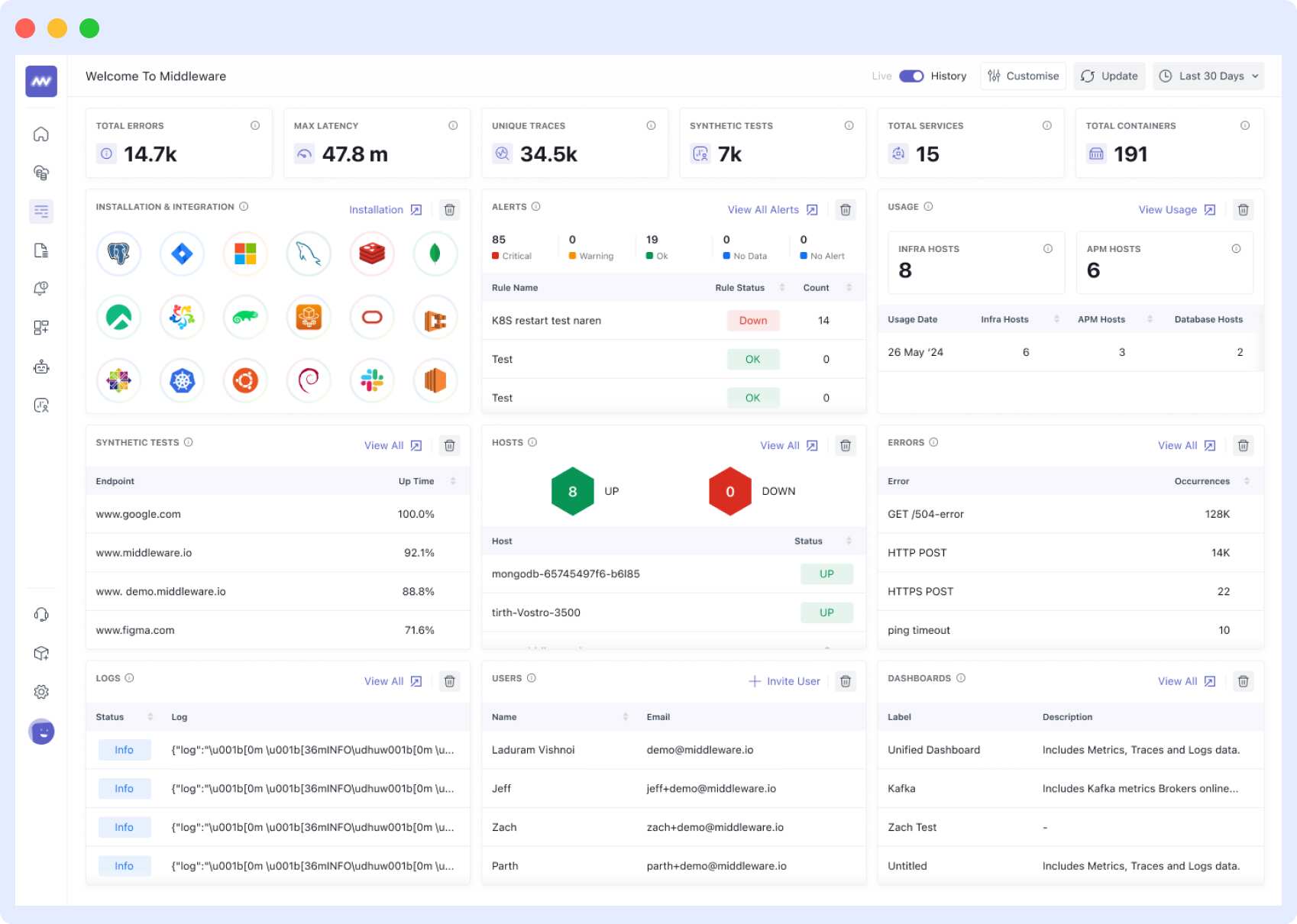
Middleware is a comprehensive observability platform that gives you a unified view of the overall health of your DevOps initiative.
All the metrics listed in the blog can be monitored in real-time and with AI-backed insight using only one tool – Middleware.
Some of the more exciting features this platform offers are:
- Full-stack visibility and flexible deployment options
- Capability to track metrics for entire infrastructure and microservices
- Real-time monitoring and interactive data visualizations
- AI-based, automated alerts to reduce MTTD
2. Prometheus
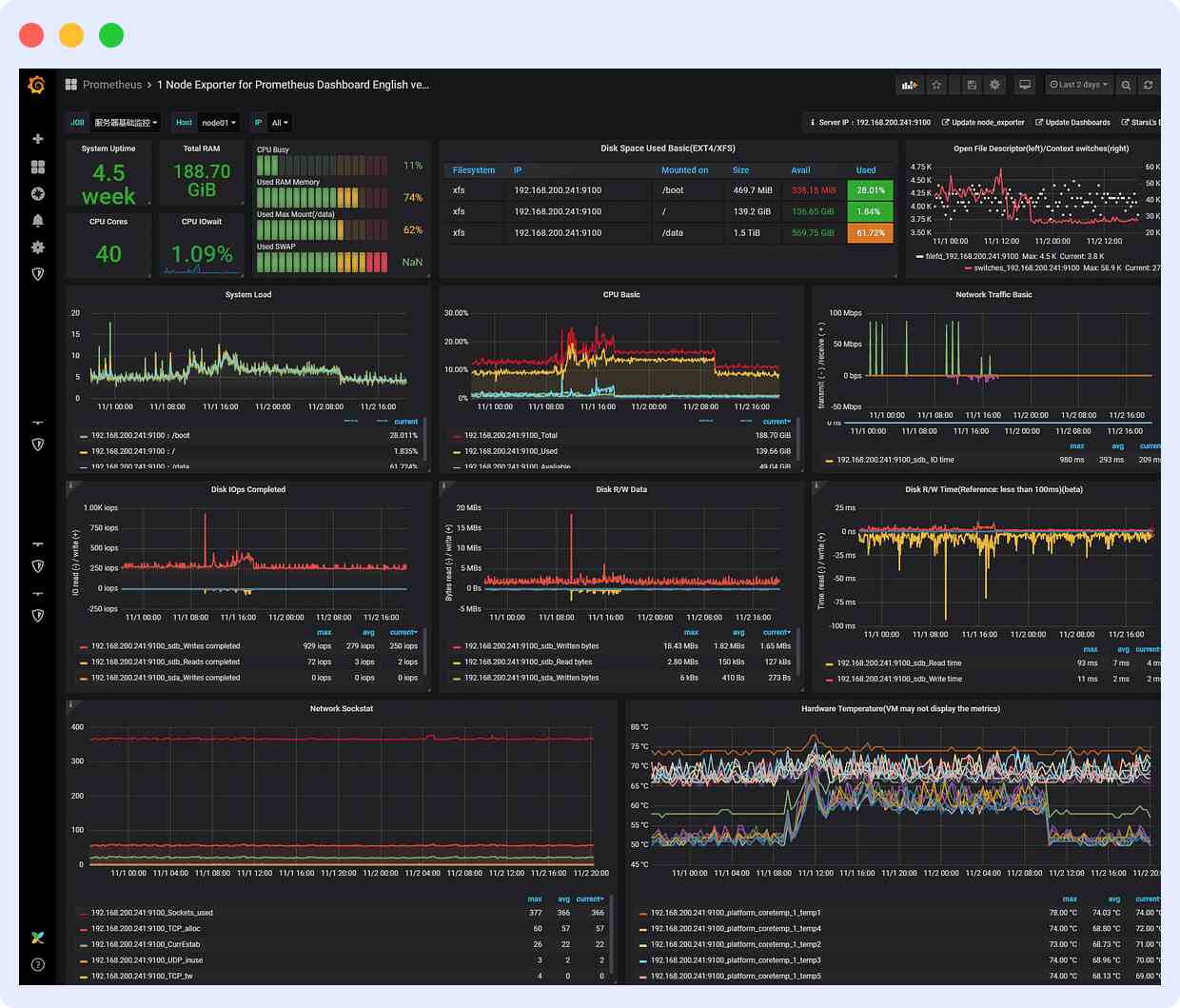
Prometheus is an open-source systems-monitoring platform that is majorly based on time series. It employs a dimensional data model in which time series are identified by a key-value pair.
You can track the key DevOps metrics using this platform; however, it may not give you information on the supplemental or all of the metrics mentioned above.
You get a host of features with Prometheus:
- PromQL and Grafana integration for data visualizations
- Local disk storage
- AlterManager for prompting incident alerts
3. Grafana
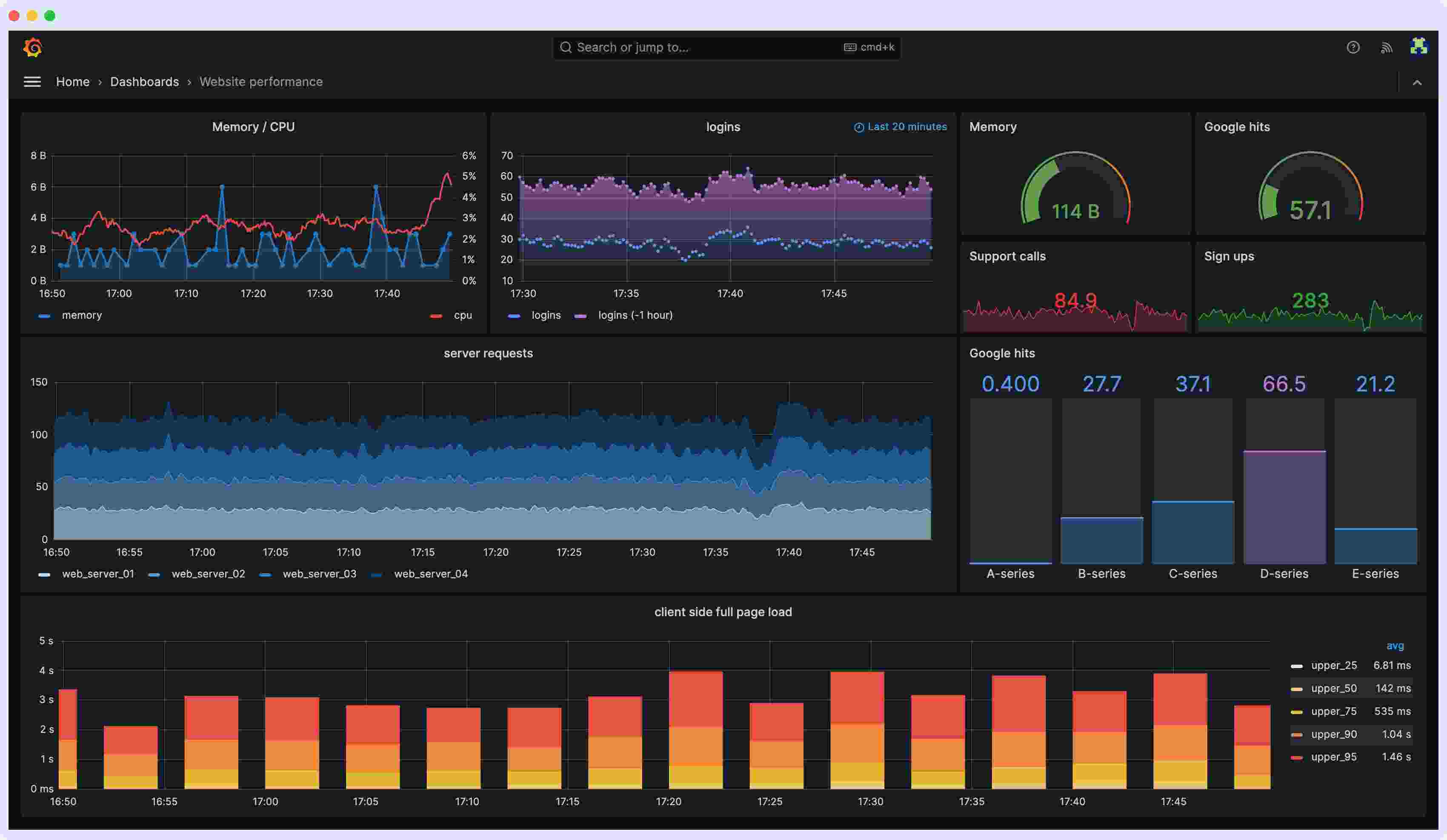
Grafana is a powerful tool that helps you unify your metrics from across various systems. Using this tool, real-time monitoring of one or two of the key DevOps metrics is possible. It may, however, not be sufficient as a full-scale DevOps monitoring tool.
Some of its key features include:
- Fast querying and global view
- Scalable and multi-tenant storage for metrics
- Out-of-the-box assembly for ready usage
- Versatile and customizable dashboards
4. Datadog
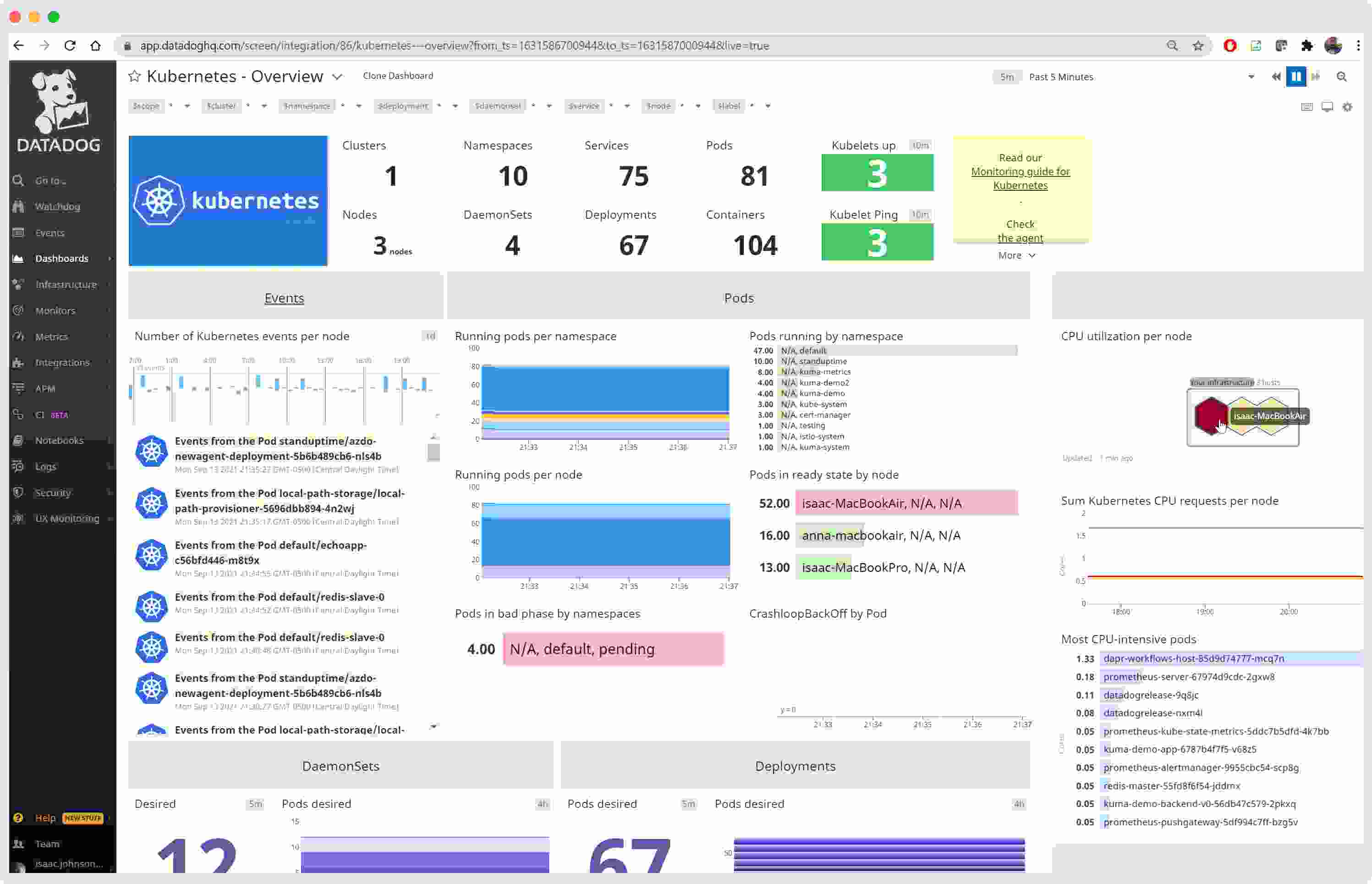
Datadog enables you to optimize your DevOps activities by providing context-driven metrics, logs, traces, and more on a single interface.
You can measure key DevOps metrics using this tool. However, if you require full visibility of your DevOps environment, Middleware is comparatively better.
Some of Datadog’s excellent features include:
- A long list of supported integrations for data collection
- Real-time dashboards for instantaneous DevOps health statuses
- Event overlays to provide context to DevOps metrics
Explore Datadog pricing to check for the best plan that fits your monitoring and observability needs.
5. Splunk
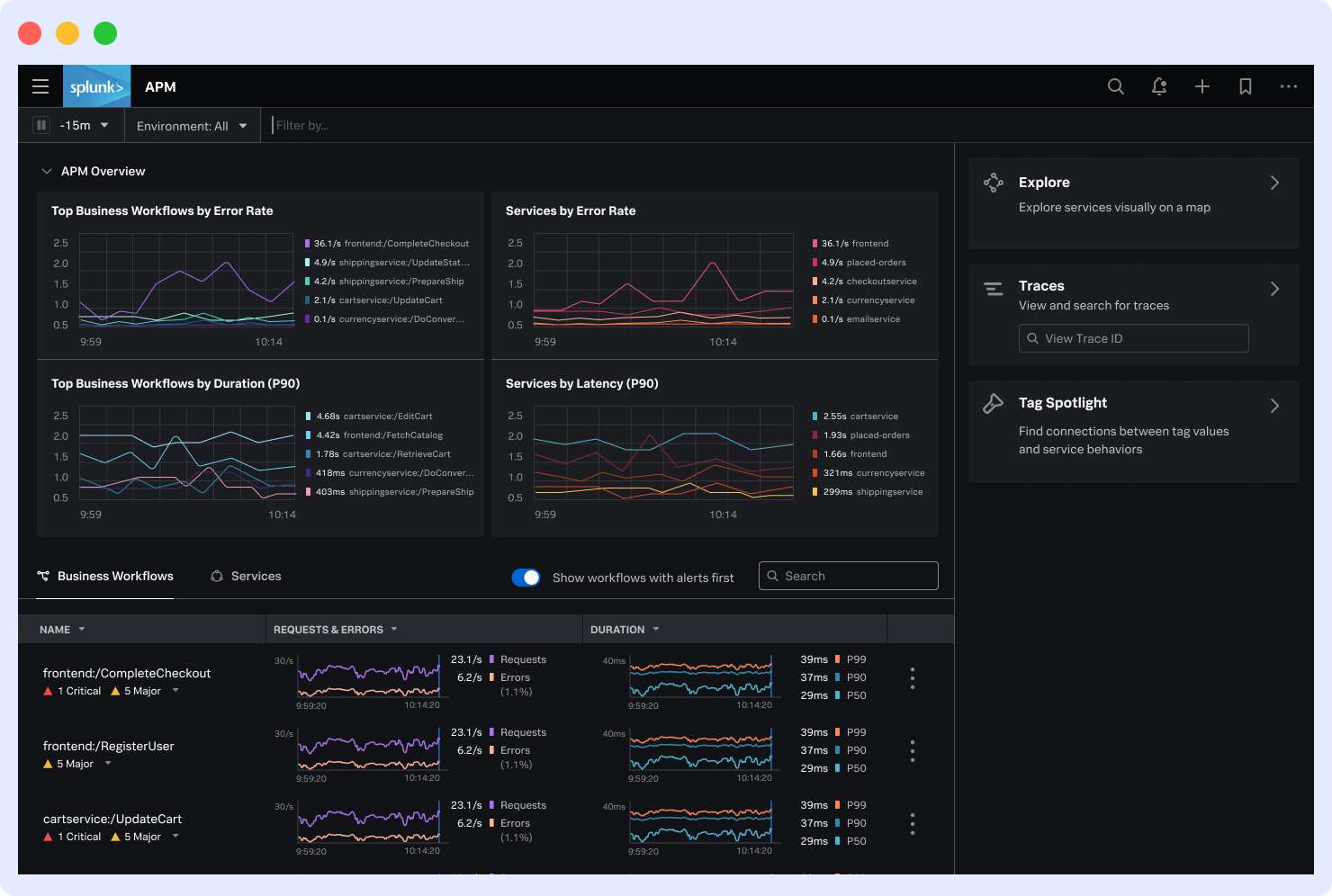
Splunk is a monitoring and visibility improvement tool that helps you eliminate the siloes in your DevOps process that enhance performance tracking and data mapping. This tool is good for monitoring operational metrics.
Some of its key features include:
- End-to-end visibility using automated observability
- Real-time insights
- Shared visibility to facilitate collaboration
- Alert routing, incident integration, and post-incident reports to improve team services
- System behavior monitoring to boost app uptime
Best practices for implementing DevOps metrics in your organization
DevOps is an extremely complex culture that involves philosophies, practices, methodologies, and processes that draw from the industry’s highest standards.
Keeping that in mind, adopting the best practices listed below helps ease into the initiative seamlessly:
1. Defining clear goals and objectives
It is possible to direct your DevOps efforts and activities better if you have clear goals established for each task and process. The metrics assigned for every element of your DevOps clearly reflect in measurable terms the realistic progress of your project towards the goal assigned.
2. Assigning responsibilities
Any process or workflow functions better when the team members know their scope of work and responsibilities. For example, assign a supervisor from the staff to monitor the automated code testing and reporting or for any other critical task. Assigning responsibility helps create ownership of the project.
3. Establishing a feedback loop
Gaining consistent feedback on the performance of the components of a system helps identify which strategies and processes are working and which need improvement.
Encourage your DevOps team and engineers to incorporate feedback – whether on team or processes, on systems or performance – and ensure that the negative feedback is acted upon.
4. Setting up a system for monitoring and reporting
One of the most important practices in DevOps is to set up a system where it is easy to monitor the processes and activities happening along the entire development pipeline.
Reporting mechanisms need to be transparent and, wherever possible, automated. It helps to establish end-to-end visibility of the development cycle.
Wrapping up
It becomes easier to improve your software and app development cycles when you know exactly what is going on, even at a microscopic level.
DevOps metrics help you achieve that visibility in your software development funnels and pipelines, enabling you to tweak and make improvements before any critical errors can materialize.
There are four key aspects that help you improve the DevOps ecosystem at your organization:
- The right people and culture that facilitate DevOps
- The right tools for implementing DevOps that enable monitoring and collaboration, like Middleware
- Timely support from seniors and leadership for encouragement and motivation
- The right ways to measure DevOps success using comprehensive monitoring and reporting tools
Once you get these four aspects nailed, your DevOps will operate at higher efficiencies and be more impactful.

